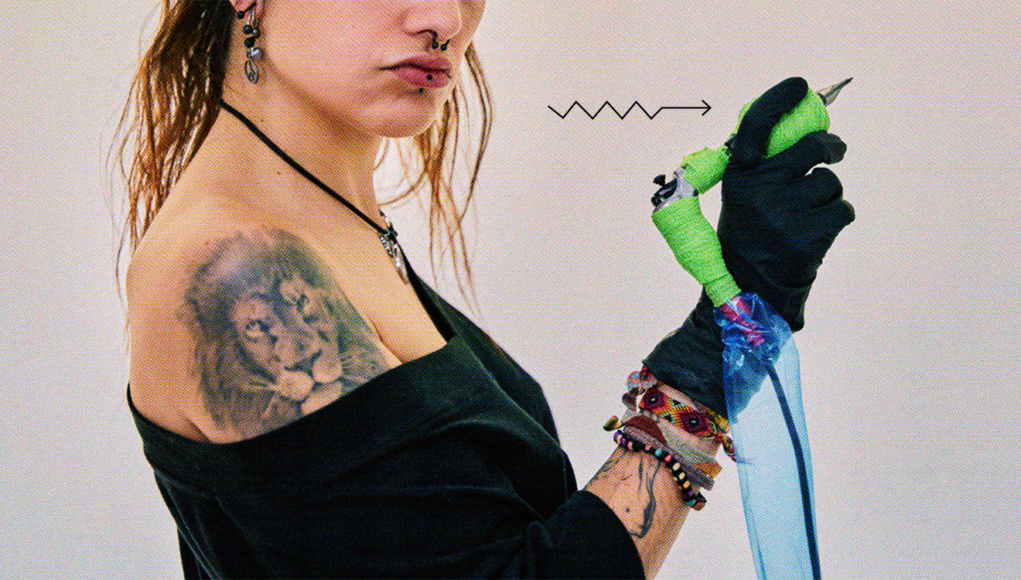If you are an artist of some kind and have a few tattoos of your own that you love, you might be thinking, hey, I should go pro as a tattoo artist! It could be the move for you, but just know that you need more than a super-steady hand. We’re talking incredible mental concentration (bc some tattoos can take literally hours or days to finish), years of hard work (some without pay) and absolute dedication to your craft. Mistakes are par for the course—and yep, they’re permanent—and while, sure, you don’t need a degree to give a client some ink, learning from skilled tattoo artists, often with an apprenticeship, is a vital part of the process. Since every artist has a different journey (and many, but not all of them, have studied fine arts), we chatted with a few people to find out how exactly they became tattoo artists. Between retired tattoer Melanie Nead, who was a custom tattoo artist for 12 years, during which time she owned Portland’s Icon Tattoo, Laura Martinez, a tattoo artist who specializes in florals and fine lines and the co-owner of Brooklyn’s Fleur Noire Tattoo Parlour, and Ashley Paige, who goes by the name Love, owner of the tattoo studio Artizmylov in Hyattsville, MD (an expert in realism, portraiture, Polynesian tribal, and colorful floral tattoos), we learned *a lot*. For one thing: It’s best to go into every tattoo with a set design plan, and make sure the artist and the client are always on the exact same page.
Here, the artists share pretty much everything you need to know about how to become a tattoo artist.
It’s common to get your start in other mediums before moving to a human canvas. “I always knew that I would be an artist. I didn’t know that I would be tattooing, specifically, but I’ve always wanted to make my living by making art,” Love says. It’s def a hustle though. She received a bachelor’s degree in painting and needed a way to make a steady living through art, so she took a leap and moved to San Diego, California, with her painting portfolio. “I went I went door to door until I found a Polynesian tribal tattoo shop that gave me an apprenticeship,” says Love. And the rest was history.
You can think about it like the difference between drawing something on paper and carving a pumpkin, explains Nead. It definitely helps to have a natural aptitude for drawing, but it takes a long time to understand the difference between what you can draw and what you can tattoo. Like anything, your tattoo drawings will improve over time—it’s critical to start out with simple designs.
“You do not need any specific education to be a tattoo artist, which is part of what I love about the tattoo world: We all come from very different backgrounds,” explains Martinez. You definitely do need to be trained, though, in sanitation, sterilization, blood-borne pathogens, and how to avoid damaging the skin while you work.
Martinez knows some people who have created tattoo schools, which do cost tuition, but “those schools are not really well-viewed in tattoo communities, so if you want to learn with someone, I recommend being patient and finding a tattoo shop and a mentor.” If you really want to understand what it’s like to be a tattoo artist, Martinez advises, “There is no better school than being in an actual tattoo shop, around tattooers and clients.”
Nobody’s great at tattooing until they practice, but the thing is—you can’t get practice without tattooing flesh. Some people practice on grapefruits, but a grapefruit can’t really compare to a nervous, sweating, breathing, vulnerable human being. Most artists start out as apprentices, which is basically like unpaid training. At Nead’s shop, they tattooed for free for the first year, just doing very simple designs. (She says you’d be surprised by how many clients you can get when you’re offering services for free.) Even a year or two after Nead started, she was still tattooing at a heavily discounted rate, simply because she wasn’t as fast or as skilled as other artists.
“My apprenticeship was ‘free’ money-wise, since I was helping at the shop (welcoming clients, cleaning floors and bathroom, setting up stations, etc.) as a compensation to my mentor for teaching me,” says Martinez. But she still had to pay the bills, so she worked at a bar on the side. “I was working all the time! Between the shop, the bar, and drawing at night, I had to give up all my free time. But it was so worth it! I loved the idea that someday I could become a tattoo artist, that it kept me motivated. I would do it all over again if I had to.”
Nead recommends getting at least two tattoo machines, a starter ink set, and tubes (which hold the needles in the tattoo machines) plus some disposable supplies, including needles, gloves, rubber bands, Thermofax paper, and skin pens. All in, it can cost upward of $4,000 in equipment to get started. In states where tattoo schools are regulated—like Oregon, where Nead lives—apprenticeships cost somewhere around $10,000 on top of state licensure fees.
Even after you start making money from your tattoos, the compensation isn’t all that flush—and you still have to pay for the supplies on your own. Basically, if you want to be a tattoo artist, don’t do it for the money.
Of course, salaries do range from one artist to another. “It requires a lot of hard work and consistency to build a unique style, your own voice, and mostly to make high-quality tattoos that don’t just look good at the moment of creation but also heal well with time,” says Martinez. Once you build a robust roster of clients, you can get paid well, but the work never stops. “When a tattooer is not working, they have to constantly find new inspirations, variety in their designs, post nice photos, and work on their portfolios, answer emails—or be sure someone who understands tattooing can do that for you,” according to Martinez. “We never really get to fully step away.”
Every tattoo starts with a consultation, which is a chance for the client and artist to collaborate on the design—and Love says that aligning on this part is key to make sure she’ll accept the project in the first place. Most of the time, when working on realism, there’s some kind of reference image she’s working from. “But when I’m working on Polynesian tribal [tattoos], there is a lot of drawing in the moment to work with the curves, flow, and contours of the body. I can do both, but my perfectionism and type-A personality prefer a solid game plan,” says Love.
Remember: Skin wrinkles and stretches and sometimes gets sunburns and scars. When you paint on a canvas, you can preserve the way that painting looks for hundreds of years. But tattoos look drastically different even two weeks after the ink has settled in and your skin has healed. Sometimes, Nead warns, people don’t take care of their tattoos and they get ruined, which feels a bit like someone buying your painting and then leaving it out in the rain. Even if you’re clear about the aftercare—no sun exposure for three weeks, only use hypoallergenic products, etc.—sometimes things go wrong, and that’s just part of working with human skin.
Love wants to make it clear that people of all skin tones should be able to get tattoos, and artists should make it a priority when they’re learning these skills to be able to accommodate all clients. “One of the biggest misconceptions is that darker-skinned people can’t get fine-art tattoos or detailed tattoo work,” Love says. It’s more about using contrast and being able to use solid black along with white highlights that can work on any skin tone, explains Love. “I believe that a truly skilled artist can create a beautiful work of art on any color canvas.”
Remember what we said about mental focus?? Well, this is where it comes into play the most. So Love, for example, works mostly on large tattoo projects. “On average, I tattoo one client for about 6 hours a day,” she says. (And the client also has to be able to sit still that long, just saying.) Other times, projects will take multiple-long-hour sessions. “The biggest benefit of working in sessions is being able to revisit a past work of art with an improved skillset,” Love adds.
People will bring you their most painful moments and ask you to turn them into artwork. During the Iraq War, Nead tattooed an active member of the military who was home on leave. She remembers that he was so raw and wounded and wanted a tattoo of his company insignia to mark how he was never going to be the same person. Sometimes people talk through those kinds of memories during their appointments, and Nead believes there’s something inherently therapeutic about the process—it can feel good to have care and attention for a few hours. As a tattoo artist, you can’t really bring your own emotional baggage to the tattoo parlor. It doesn’t matter if you’ve had a stressful morning—you need to learn to leave that stuff outside the door and be completely there for that person in the moment.
There are two traditional models for tattoo parlors, with various combinations between the two: First, there are walk-in shops, where clients are primarily asking to get a tattoo on the spot. They choose from pre-drawn designs in the studio, and after the appointment, you might never see them again. Then there are all-custom shops, where artists work with clients ahead of time to design something original. It can take months of drawing and talking through the tattoo before someone eventually gets it done. The process of creating custom tattoos can be incredibly rewarding because of the profound relationships you form with your clients. At the same time, it’s sometimes a relief to meet a walk-in, where all you have to do is put the ink on someone without having to invest in creating the tattoo over an extended period of time.
When you’re first starting out, it can feel like almost all your lines are crooked or inconsistent. Even once you get good, you’re not immune to mistakes. Spelling errors can happen with text tattoos if the artist and client don’t triple-check. Nead knows someone who tattooed the Superman logo on someone, and when he finished, he realized he’d put it on backward. When something like that happens, you can’t reverse it. You just have to apologize and offer to cover it up for free.
“It’s really hard to accept and face your own mistake, especially when it’s on someone’s body forever. I personally had nightmares about it in the beginning!” confesses Martinez. “But you only become a good tattooer when you put your fears and ego [aside], learn from your mistakes, and practice harder to never, ever let it happen again.”
There’s no way for a client to know what makes a good tattoo—that’s something you can only learn from years of tattooing—so Nead says it’s your job to provide guidance and feedback about the tattoo they want to get. Of course, some people are stubborn about their ideas, so if you can’t visualize a way to make their concept look good as a tattoo, you should turn them away. Nead doesn’t do tattoos that she finds offensive or in poor taste.
In Nead’s experience, if people plan to get a tattoo on their hip or their belly, they’ll sometimes say negative things like, “I guess I need to lose weight now that I’ll have this tattoo.” But once they get the tattoo, they suddenly become very proud of that part of their body. It’s cool to be able to help someone change how they feel about their body in a positive way.
You’re basically sitting hunched over and holding a static position for upward of 10 hours a day. It’s really common for tattoo artists to have back problems. Nead eventually developed tendonitis in her arms, which got so bad that she can no longer tattoo full-time anymore.
It’s not physically impossible to give yourself a tattoo, but it’s near mentally impossible. “I have tattooed myself and…it hurts, so my preferred practice skin is my youngest brother,” Love says. ”His pain tolerance is much higher than mine and I get to create art with no pain.”
If you’re critical of yourself, this can be a challenging line of work. Nead says there are little things she would’ve done differently even in her favorite designs. Still, there’s something super satisfying about watching someone go to the mirror and see their tattoo for the first time. They’re not criticizing all the tiny details—they’re marveling at how you turned their idea into art that they’ll carry with them for the rest of their lives.
“Be really motivated. Draw a lot. Understand the consequences of tattooing someone.” These statements are pretty much Martinez’s mantra. There are also health consequences to consider, according to Martinez:
Your clients should feel safe and comfortable in your shop. Period. “As a woman of color and a member of the LGBTQIA+ community, I created Artizmylov in response to the exclusionary tendencies of the tattoo community,” Love says. The process of getting a tattoo should be inclusive, whether someone identifies as BIPOC, LGBTQ+, is part of the plus-sized community, or has certain skin concerns, including stretch marks or moles, adds Love. Her number-one priority is making sure her business is a safe space, and that starts with the bodies that are featured on an artist’s website or Instagram. The consultation is also a key moment in making all clients feel seen. “It’s all about communication with the client and ensuring their wants and needs are heard and executed with the tattoo,” says Love.
“Before becoming a tattooer, I had admiration mixed with a lot of fear of this industry that seemed very impressive and also inaccessible from outside. Since I went to the other side, from being tattooed to becoming a tattooer, I have met the sweetest, nicest people ever,” says Martinez. “I have always been respected, well treated, welcomed. I found a family in this industry that I wish I had known before. All the clichés were completely wrong and I have only (mostly) met incredible and welcoming artists who inspire me and encourage me.”








